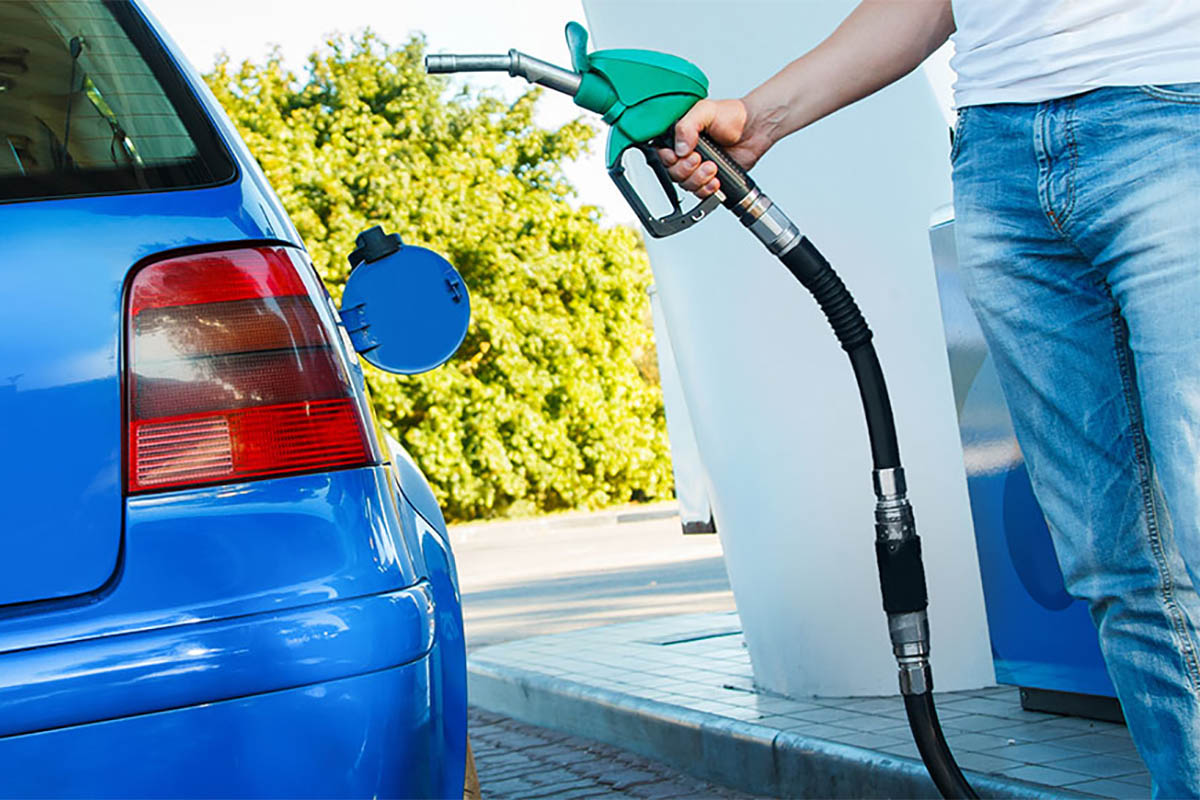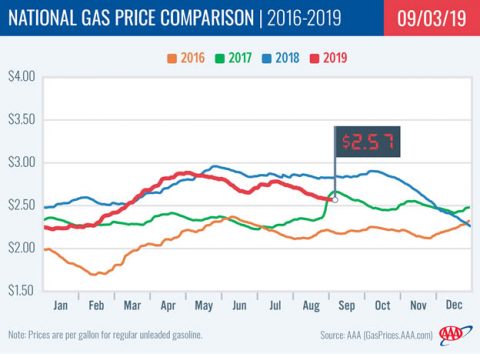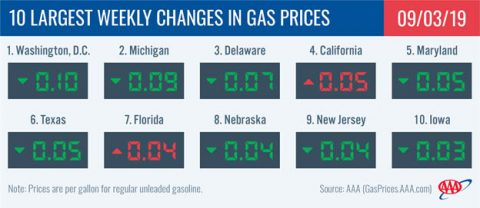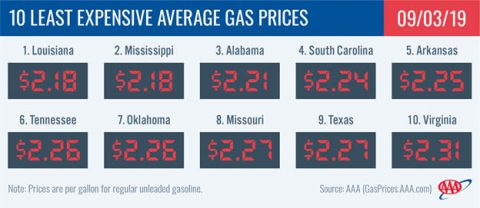 Tampa, FL – On the week, AAA says gas prices are as much as nine cents cheaper in every state except California, (+5 cents), Florida (+4 cents), Ohio (+2 cents) and South Carolina (+1 cent).
Tampa, FL – On the week, AAA says gas prices are as much as nine cents cheaper in every state except California, (+5 cents), Florida (+4 cents), Ohio (+2 cents) and South Carolina (+1 cent).
Hurricane Dorian has been the driver for the increases in Florida and, most likely, South Carolina.

“As an east coast storm, Hurricane Dorian is not threatening major oil and gas infrastructure so its impact is localized to its path along the East Coast,” said Jeanette Casselano, AAA spokesperson.
“For the rest of the country, demand, which remains high, is chipping away at supply, but not at a high enough rate to increase gas prices,” Casselano stated.
Today’s national average is $2.57, which is a penny cheaper than last week, 14-cents less than a month ago and 26-cents cheaper than a year ago.
Quick Stats
- The nation’s top 10 least expensive markets are: Louisiana ($2.18), Mississippi ($2.18), Alabama ($2.21), South Carolina ($2.24), Arkansas ($2.25), Tennessee ($2.26), Oklahoma ($2.26), Missouri ($2.27), Texas ($2.27) and Virginia ($2.31).
- The nation’s top 10 largest weekly changes are: Washington, D.C. (-10 cents), Michigan (-9 cents), Delaware (-7 cents), California (+5 cents), Maryland (-5 cents), Texas (-5 cents), Florida (+4 cents), Nebraska (-4 cents), New Jersey (-4 cents) and Iowa (-3 cents).
South and Southeast
Hurricane Dorian drove Florida’s gas price average up four-cents on the week and is starting to impact pump prices in Georgia and South Carolina by pennies. Some gas stations in the Sunshine state were reporting fuel shortages, due to motorists filling-up ahead of the storm.
Those shortages will be short-lived as fuel will be re-supplied once tanker trucks can travel into any impacted areas.
The region saw a nearly 3 million bbl draw on gasoline stocks in the Energy Information Administration’s (EIA) report for the week ending August 23rd. That drop brought total levels down to 80 million bbl, which is the lowest regional supply level since mid-April of this year. Regardless, it is a healthy supply level and provides the ability to replenish any shortages in Florida.
Great Lakes and Central States
Most states in the Great Lakes and Central region have gas price averages that are two to four cents cheaper than last week. Michigan (-9 cents) and Ohio (+2 cent) are the outliers. Illinois ($2.71) carries the most expensive average followed by Ohio ($2.59) and Michigan ($2.58). On the other side of the coin, Missouri ($2.27), Kentucky ($2.32) and Kansas ($2.32) are the cheapest in the region.
Indiana (-35 cents), Kentucky (-23 cents) and Illinois (-22 cents) lead the nation with the largest monthly decreases. Ohio (-21 cents), Wisconsin (-19 cents) and Missouri (-19 cents) round out this top 10 list.
Gasoline stocks remain stable at 51 million bbl, the healthiest supply level seen since April for the Great Lakes and Central states region. Regional refinery utilization hit 100% in the EIA’s latest report. The high refinery rate and healthy stock level are working together to push prices cheaper for most of the region, a trend that should continue into September.
Mid-Atlantic and Northeast
Four Mid-Atlantic and Northeast states land on the top 10 list for largest weekly decreases: Washington, D.C. (-10 cents), Delaware (-7 cents), Maryland (-5 cents) and New Jersey (-4 cents). All states have cheaper gas prices, with a penny being the smallest decline since last Monday.
Regional gasoline stocks added 1.6 million bbl for the week ending Aug. 23. At 63.9 million bbl, stock levels are at their highest point in three months and on par with levels this time last year. This is positive news for the region in light of stock decreases seen earlier this summer due to the fire and explosion at the Philadelphia Energy Solutions (PES) refinery in Pennsylvania. With regional refinery utilization down to 66%, it’s likely that most of the increase in supply is a result of imports.
Rockies
Utah (-4 cents) had the largest decrease in the region on the week followed by Idaho (-3 cents). Meanwhile, pump prices in Idaho, Wyoming and Montana only decreased by a penny or two. At $2.54, Colorado saw no movement.
Compared to this time last year, gas prices are at least 30-cents cheaper in all states except one: Idaho (-45 cents), Utah (-37 cents), Colorado (-33 cents), Wyoming (- 30 cents) and Montana (-22 cents).
EIA data reports regional refinery utilization increased for another week, this time to 102%, though gasoline stocks dipped by about 200,000 bbl down to 7.4 million bbl. As utilization holds strong, gas prices will continue to be cheaper for motorists in the Rockies region.
West Coast
Pump prices in the West Coast region are the highest in the nation, with all states in the region landing on the top 10 most expensive list today. Hawaii ($3.65) and California ($3.62) are the most expensive markets in the country. Washington ($3.19), Nevada ($3.12), Oregon ($3.04), Alaska ($2.96) and Arizona ($2.82) follow. Most state averages in the region have decreased on the week, with Alaska (-2 cents) seeing the largest decline. However, California (+5 cents) saw the largest increase.
The EIA’s recent report for the week ending on August 23rd showed that West Coast gasoline stocks decreased by 600,000 bbl. The total level is now 29.02 million bbl., which is more than 700,000 bbl higher than last year at this time. The higher level could help prices stabilize if there is an increase in gas demand in the region this week.
Oil Market Dynamics
At the close of Friday’s formal trading session on the NYMEX, WTI decreased by $1.61 to settle at $55.10. Crude oil prices saw some gains last week following EIA’s weekly report that showed crude oil stockpiles had decreased by 10 million bbl.
However, worries about the impact of Hurricane Dorian drove crude oil prices down late last week. Closing out the week, crude oil futures fell 3% ahead of the hurricane’s landfall with fears that its impact could dampen demand. Market watchers will continue to track the progress of Hurricane Dorian as it strengthens throughout the week and batters Florida and the east coast.
Motorists can find current gas prices along their route with the free AAA Mobile app for iPhone, iPad and Android. The app can also be used to map a route, find discounts, book a hotel and access AAA roadside assistance. Learn more at AAA.com/mobile.






